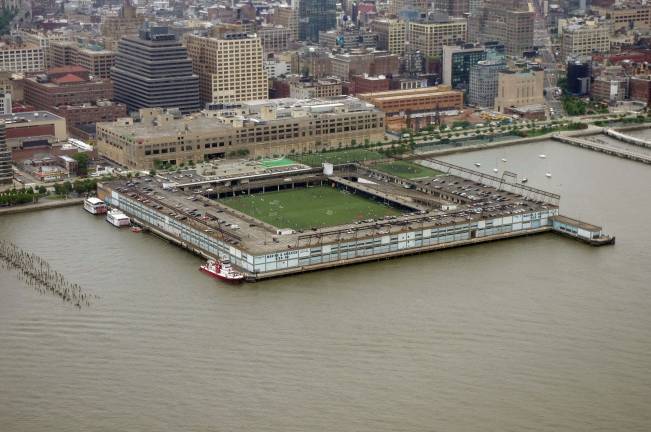What’s next for pier 40?

Months after the City Council approved an air rights transfer deal that will fund repairs of Pier 40’s crumbling pilings, attention has shifted away from the pier’s structural demise and toward plans for its potential redevelopment.
At a May 25 meeting of Community Board 2’s Future of Pier 40 Working Group at the Village Community School on West 10th Street, local residents discussed the future of the 15-acre recreational complex on the Hudson River near West Houston Street.
In December, the City Council voted to approve a $100 million deal transferring 200,000 square feet of air rights from the pier to the developers of a planned high-rise residential and retail complex at St. John’s Terminal, which sits opposite the pier across the West Side Highway. The funds from the air rights transfer will be used to repair the deteriorating pilings that hold the pier above the Hudson.
Even after the deal, Pier 40 retains significant air rights that could be used for further development at the site to generate additional revenue for the Hudson River Park, possibly in concert with commercial interests. A future iteration of Pier 40 could conceivably include recreational space alongside residential housing and retail space, which some fear could change the character of the park and surrounding neighborhood. The Hudson River Park Trust did not respond to a request for comment on redevelopment plans for the pier.
Apart from serving as home to recreational sports organizations, Pier 40 is a crucial revenue generator for Hudson River Park Trust, which operates the four miles of West Side riverfront park space that includes the pier. Income from Pier 40’s parking garage currently helps fund operations elsewhere in the park, and any future plans for the pier would likely need to replicate — or potentially add to — that revenue.
“We have to start talking about the park as a park in general, and not isolated development pieces,” state Assembly Member Deborah Glick said in an interview after the meeting. She added that opportunities for new revenue and open space should be explored elsewhere along the Hudson, such as at Pier 76, which currently serves as an NYPD tow pound.
Any successful proposal will have to strike a delicate balance, satisfying the park’s revenue requirements, preserving or expanding existing recreational opportunities, and, possibly, meeting the commercial needs of private partners — all while simultaneously allaying community concerns about overdevelopment.
Two previous pushes to redevelop Pier 40 failed in the fact of community opposition, including one plan, derided by critics as “Las Vegas on the Hudson,” that would have moved the fields to the roof of a redesigned complex housing a permanent Cirque du Soleil venue. Tobi Bergman, the Community Board 2 member who chairs the Pier 40 working group, emphasized the need to root any future redevelopment efforts in popular consent from the outset. “It’s important that we not go down the same failed road we went down twice,” Bergman said. “In order to do that, the idea is to build some kind of consensus about what the constraints of development are from a community standpoint.”
“The first priority of this process can’t be that it’s got to bring in a lot of money,” he added. “The first priority is that it has to be great open space.”
The chief concern of many at last week’s meeting was the preservation of existing park space in any future redevelopment. Various constituencies — soccer players, Little League parents, dog owners — attended the meeting to express their wishes. Members of the Village Community Boathouse, for example, turned out in droves to request that redevelopment plans, in whatever form they take, include a spot for their group along the pier’s southern side, where the boats are protected from prevailing currents.
The individuals present at the meeting emphasized that the pier is a vital amenity to residents from well beyond the immediate West Side community. New Yorkers from as far as Hell’s Kitchen and Brooklyn spoke of how they regularly use the facilities. The pier’s importance will only grow, according to several residents, as population density increases in Greenwich Village, spurred on by new developments like the St. John’s Terminal project, and the park attracts additional users from further afield, such as residents of the Hudson Yards development roughly two miles north.
Ideas presented by community members ranged from the modest — improved restrooms and concessions, shipping containers retrofitted to serve as offices and storage, perhaps a dog run or a running track — to grandiose visions of a new pier with multiple levels of indoor and outdoor fields, funded by commercial development on the site.
“I don’t mind thinking big but we also have to think smart,” Glick said. “I think there’s always a middle ground and there’s always a way to find it. But you can only find it if you have a true public conversation and do some market research,” not only on potential commercial uses, but on public preferences as well. Glick suggested that a survey would be needed to gather input from community members not represented at meetings like the one last week.